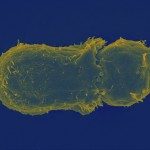Lien vers Pubmed [PMID] – 9300530
Res. Immunol. 1997 May;148(4):231-45
Activation of T lymphocytes by T-cell receptor (TCR) ligands such as peptide/MHC complexes, superantigens or anti-TCR mAbs, or by pharmacological activators of protein kinase C such as phorbol esters, results in the internalization and cell surface downregulation of TCRs. We investigated the role of internalization motifs located in the cytosolic region of CD3 gamma in the internalization of TCR complexes induced by enterotoxin superantigens, anti-TCR mAbs or phorbol esters. To this end, a series of CD3 gamma mutants were expressed in a CD3 gamma-deficient variant of the human T-cell line Jurkat. We found that serine126 and the di-leucine motif (Leu131-Leu132) are required for phorbol-ester-induced TCR downregulation, but they are not necessary for enterotoxin superantigen or antibody-induced TCR downregulation. Moreover, the tyrosine-based motifs (residues 138 to 141 and 149 to 152) are not required either for phorbol aster or for superantigen or antibody-induced TCR downregulation. Confocal microscopy analysis reveals that TCR complexes accumulate in an early endocytic/recycling compartment upon activation of cells with phorbol esters, whereas TCRs internalized upon activation with superantigen or anti-TCR mAbs are routed to lysosomes. Consistent with this intracellular localization, TCRs internalized in response to phorbol ester are not degraded and can be reexpressed on the cell surface. In contrast, TCRs internalized upon superantigen activation are degraded.

